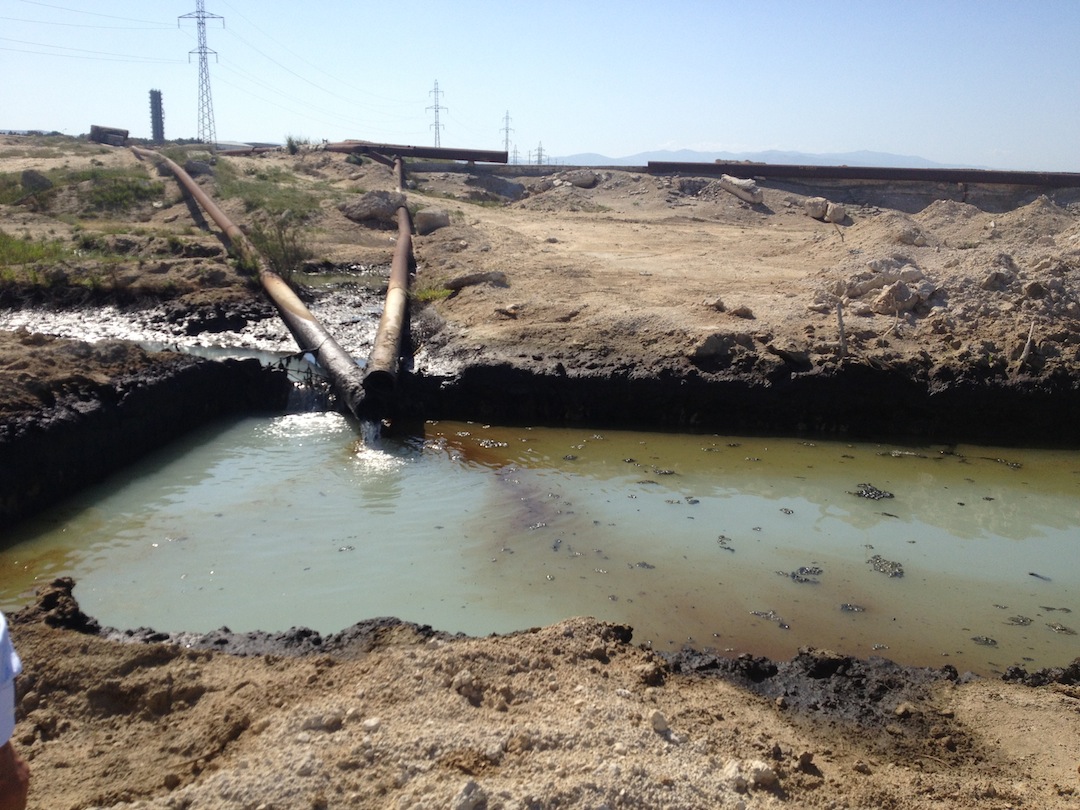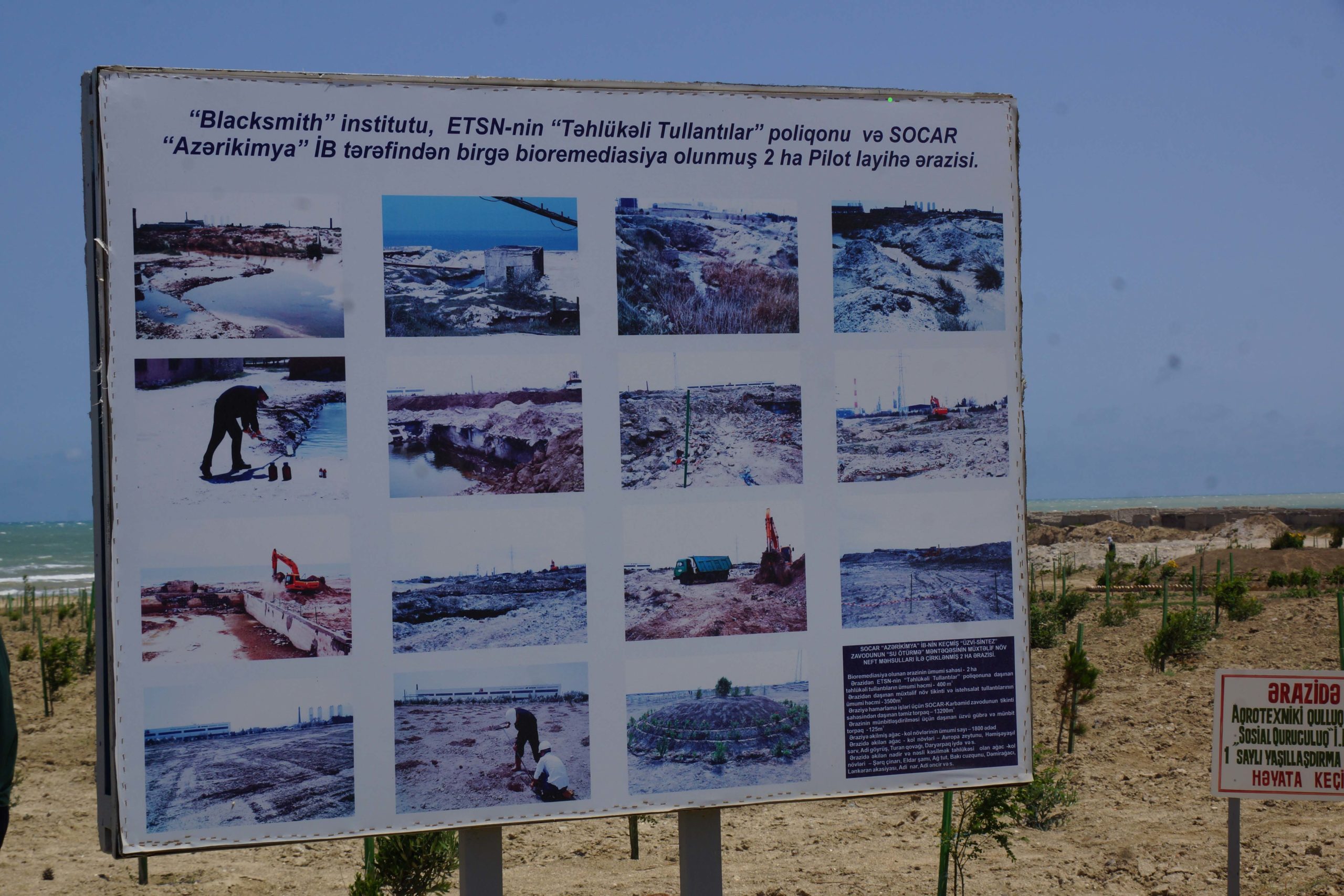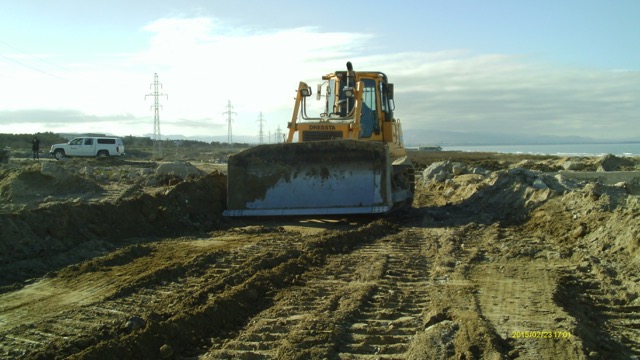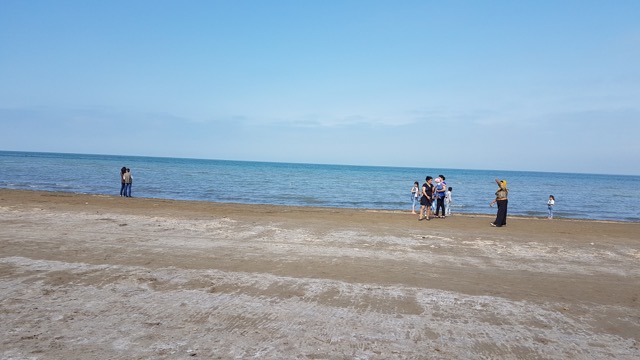This post comes from Rovshan Abbasov, Pure Earth’s country coordinator in Azerbaijan. Rovshan shares his story about pollution in Azerbaijan, and a childhood caught between clean and polluted. (WATCH VIDEO BELOW)
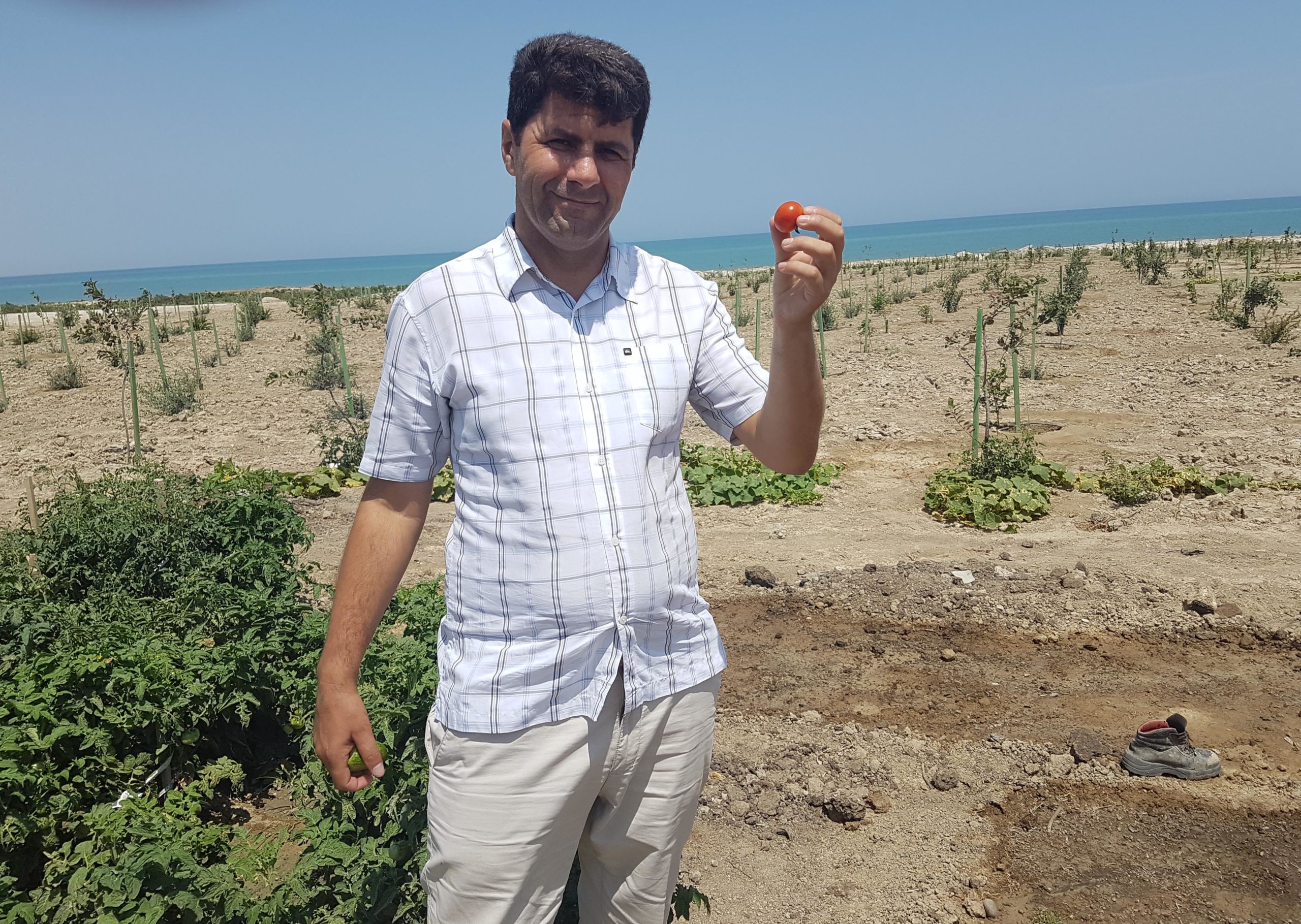 Dr. Rovshan Abbasov, Pure Earth’s coordinator in Azerbaijan, holding a tomato from new plantings at the site of a remediated beach in Sumgayit.[/caption]
Dr. Rovshan Abbasov, Pure Earth’s coordinator in Azerbaijan, holding a tomato from new plantings at the site of a remediated beach in Sumgayit.[/caption]
My name is Rovshan Abbasov. Currently, I am head of the Environmental Research Centre of Khazar University and Pure Earth’s country coordinator in Azerbaijan.
Azerbaijan is a place where Pure Earth is very active, with 150 sites identified under the Toxic Sites Identification Program (TSIP), and one big remediation project in Sumgayit.
Azerbaijan used to be part of the Soviet Union and is located on the west side of the Caspian Sea. This is a multicultural country, where many ethnic groups live together in a vast variety of landscapes: mountain ridges, valleys, plateaus, as well as plains. The country is very famous for its petroleum industry, but wines, brandies, and high quality fruits and other products make the country very attractive for tourists.
Baku is a capital city of Azerbaijan, a city that is considered the mother of the world’s petroleum industry. By 1901, Baku produced more than half of the world’s oil. Recently, it has become one of the most important tourist destinations in the Caspian region.
A Childhood in Azerbaijan with “White Gold” and DDT
I was born in a small village in Azerbaijan, with low elevation, surrounded by endless cotton fields. At that time, Soviet Azerbaijan used to produce one million tons of cotton yearly. Cotton was a proud export of the nation, referred to as “white gold.” I started collecting cotton when I was 8 years old, in 2nd grade.
As a rule, in Azerbaijan, as in the rest of the Soviet Union, schools start on September 1 and finishes on May 31, but children of cotton producing districts of Azerbaijan had little time for school. For us, cotton collection was more important than schooling. That is why we started school on November 1 and continued until April 15. September and October were best times for cotton collection. Because I was very small, I was not able to collect much and 10 kg a day was considered normal for kids my age. The grueling work was so tiring, we sometimes slept between cotton plants.
Something I remember very vividly was the small planes we always saw flying over us at a height of no more than 4-5 meters. Many children my age and older stayed near the field and looked at the planes with interest. I always saw a white powder with terrible odor spill from the planes. Sometimes I had a headache after smelling the powder. Later, I learned that it was poisonous DDT.
Pristine Summers in Yurts
I was a lucky, because I was Terekeme. Terekeme are Turkic people that spend part of the year in mountain areas, and summer pastures. When schools closed, I went to the mountain area with sheep and lived in a yurt for almost three months a year. We built our yurt in alpine grasslands of the Caucasus. The area was absolutely clean and unspoiled by agriculture or other human intervention. All the children played ball, and ran around yurts. Soccer was the most preferred game for both boys and girls.
There were eight people in my family, my parents, my brother, four sisters and I. My father was a veterinarian, and my mother was a housewife, who was a very kind person. My grandmother became a widow, after my grandfather died in World War II.
During the month of May, as was usual, all of my family moved to the mountains. My grandmother stayed at a place called Aran, which is where we lived from September to May. Our Mountain home was a yurt made from special tent material and long pieces of wood.
The pastures where I spent my summers were endless grasslands filled with different types of flowers. Every day we drank high quality milk, and ate yogurt, cheese and lived in an absolutely pristine environment. Every afternoon I helped adults milk our sheep. After that, my mother cooked the milk and emptied it into a very large pot and covered it. The next morning we had very nice crème… I am sure I will never have that wonderful flavor again.
Polluted and Clean, Misery and Joy
At the end of August, it was time to go back to my village again. Again to cotton…and again to DDT.
I was able to see and compare my two different living experiences. Cotton and flowers… DDT and milk cream… Polluted and clean … Unhealthy and healthy… Misery and joy!
When I finished studying geography in school, I began studying Environmental Science. I had so many questions that I wanted to find answers to: Why, when we have the opportunity to have a clean earth, do so many prefer it polluted? Why should people be miserable if there is another option?
For me, pollution is an evil that kills the perspective and passion of people.
A Most Important Letter
I started to work at the Khazar University, where I found myself completely immersed in my subject area. There, I established the Environmental Research Centre. The Centre became a central point in environmentalist life in Azerbaijan. The working environment in the university is very open to new ideas and solutions, if someone has a new idea for implementation, it is very welcomed.
One day I received a letter from Andrew McCartor, then Pure Earth regional director for the Former Soviet Union, who asked me to be a coordinator for Azerbaijan. Later, I understood how one letter can change the life of a person.
I started to work as part of Blacksmith Institute/Pure Earth’s staff. We made nearly 130 environmental assessments for Pure Earth’s Toxic Sites Identification Program (TSIP). We also attended many meetings, conferences and seminars sharing what we were discovering.
A Helper, Not A Criticizer
In 2007 Sumgayit, Azerbaijan, was listed in the Top 10 World’s Worst Polluted Places report. One day I received a phone call and a person whom I did not know invited me to Sumgayit. I found out that his name was Vugar Karimov, vice president of Azerkimya, a local chemical company that produces different chemicals in Sumgayit.
When we met he said: Most of the areas in Sumgayit were polluted long before Azerkimya was established. Environmentalists like to criticize. We have too many critics in Azerbaijan. But you cannot imagine how difficult it is to be a chemical worker with so many environmentalists around. We have nearly one hundred polluted legacy sites here. Who will take care about of these sites?
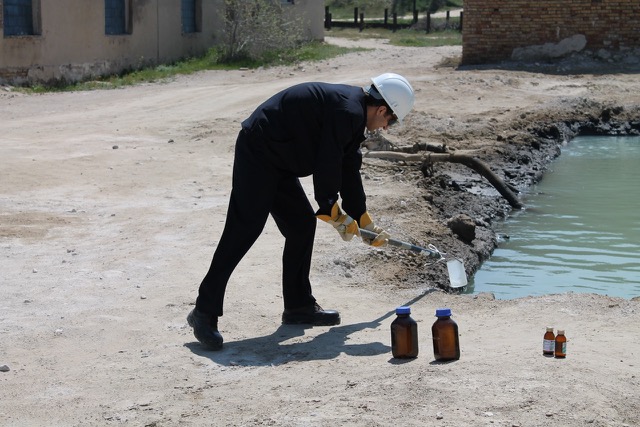 Testing polluted water at a site in Azerbaijan.
Testing polluted water at a site in Azerbaijan.
I said: We do not just criticize. We talk about problems and show ways to solve them. We identify problems and help to manage them.
Later Azerkimya expressed its interest in cleaning an area near Sumgayit and contribute to the remediation process. Then we started with our official business.
 Testing polluted water at a site in Azerbaijan
Testing polluted water at a site in Azerbaijan
Things in Azerbaijan happen, but they happen very slowly. I knew this and went into this job with a lot of patience. You have to meet a lot of people, explain the situation and be seen as a helper, not a criticizer.
Coming Together To Clean A Toxic Beach
The site we decided to clean was close to the beach of the Caspian Sea. (Scroll below to read stories of the cleanup)
Polluted water flowed into the sea through the sand. The remediation site was once a disposal area for wastewater residuals from the state-owned Organic Synthesis Plant and Ethylene-Propylene Plant, and waste sludge from calcium hydroxide (Ca(OH)2) production. The main contaminants at the site were benzene, benzo(a)pyrene and polychlorinated biphenyls (PCBs).
The site was not guarded and the nearby area was used as a beach. Liquid waste soaked into the ground or flowed into the Caspian Sea. Contaminants in dry waste on the ground were transported by frequent winds to factories and residential areas, where people work and live.
As a geographer, it was not difficult to imagine a nice and clean beach with golden sand. It was clear that the pollution turned this beautiful place into hell for people. One could see sludge of contaminants everywhere. Toxic liquid waste from one of the many industrial plants was evaporating. Sludge of contaminants was mixed with the nice sand of the beach.
The Team
Andrew McCartor, Bret Ericsson, Oktay Taghizade, Vugar Karimov, Petr Sharov (Pure Earth’s current regional director for the Former Soviet Union) and Barbara Jones are the people who contributed to the remediation of Sumgayit site. Thank you friends. Without your contribution, everything would be quite different.
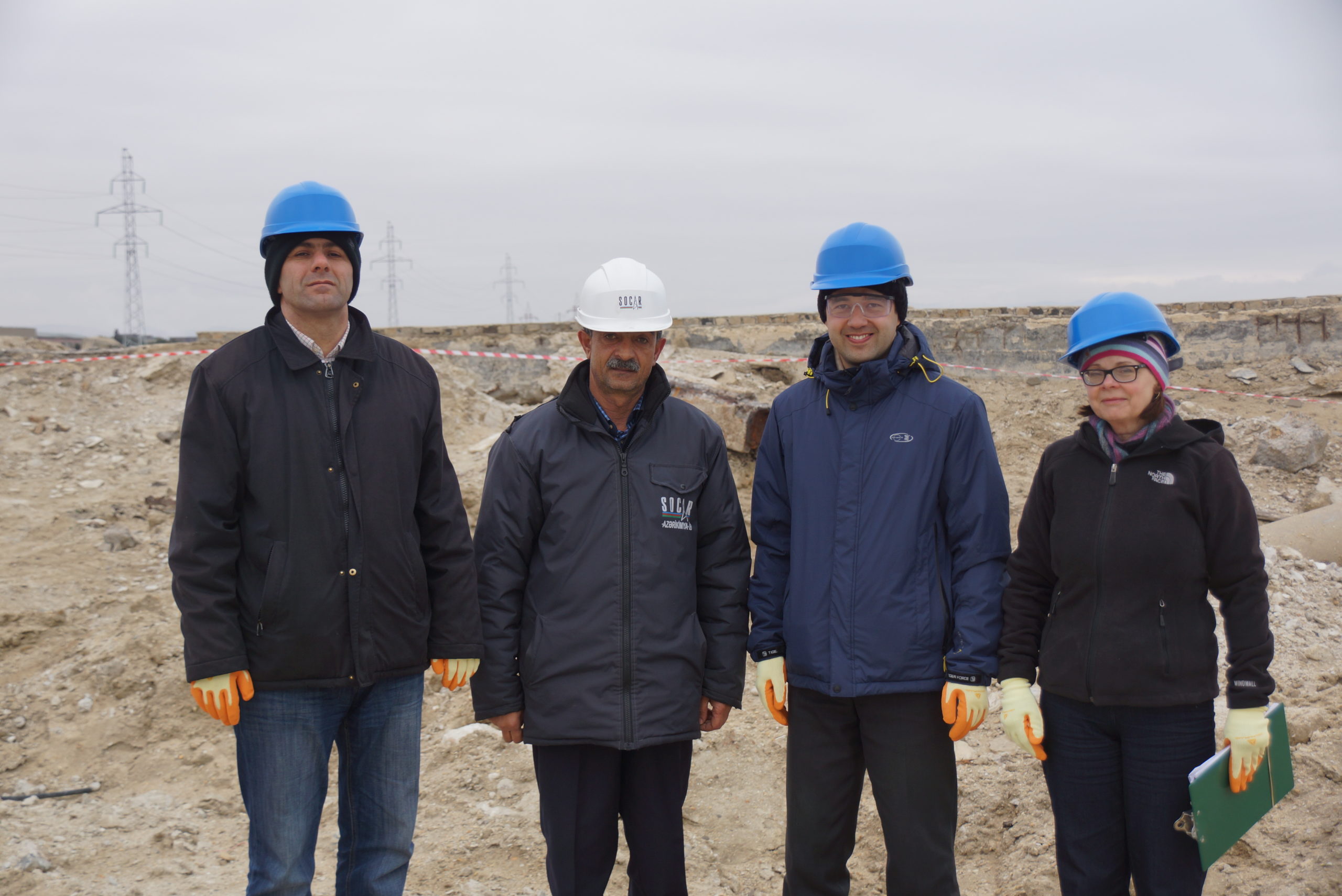 Part of the Pure Earth cleanup team, which included Barbara Jones (right)
Part of the Pure Earth cleanup team, which included Barbara Jones (right)
Petr Sharov’s smart decision to clean the site was fantastic. No more official letters and papers, he said. We should start right now!
I always go back to read Barbara’s diary. What did we do? What did others do? I am very lucky person. Thank you my friends, for everything you make for me, and my country. You are real heroes of this contaminated world.
From the Diary of Barbara Jones:
The Sumgayit remediation project was initiated on Wednesday, February 11, 2015. Ten truckloads carrying an estimated volume of 100 m3 of waste material were delivered to the toxic pollutant’s landfill about 15 km away. The excavation locations were north and south of the former wastewater settling pond, where wastes and contaminants were known to have been placed. Photograph 6: Loading wastes for transport to the landfill
On Friday, February 13, eight trucks were loaded and taken to the landfill. Because of the rain, the material was heavier per m3 compared to Wednesday, so the trucks were not quite as full. Still, an estimated 80 m3 were transported. The truck invoices were in order, and no paperwork problems were encountered. The trucks were not covered, but because of the rain the material was not dusty.
February 16 was a sunny day. Ten trucks of waste, each 11 m3, were removed to the polygon.
February 17 was a sunny day. Eight trucks, each 11 m3, were removed to the polygon. By April 4, 804 m3 of contaminated soil were removed to the polygon.
The Sumgayit remediation project covers more 2 hectares of land, located on a beach. We have extracted nearly 1000 tons of contaminants to the toxic polygon of the Ministry of Ecology and Natural resources.
Now, after the clean up, there are trees and flowers in the area, benches near the sea, and hills that are full of flowers. An ecosystem has returned. Oktay Taghizade planted tomatoes and cucumbers on the site, and they are growing well!
We did this. The sorrow turned into joy.
Recently, I took my little son there. He was running among trees… and I remembered my childhood. I hope my son can grow up on a more pure earth than I did.
VIDEO:
Related:
A Toxic Beach in Azerbaijan Gets Cleaned Up, Solar Baths Become Safer





